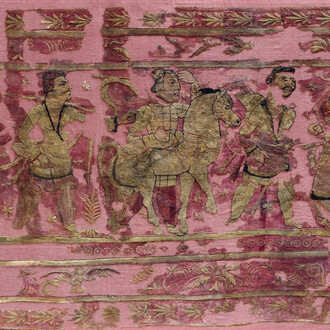Galerie Urs Meile is pleased to announce A pre-arranged life, the first solo exhibition in Zurich by the emerging Chinese artist Miao Miao (b. 1986, China). As a leading voice among the young generation of Chinese artists, Miao Miao’s practice moves fluidly between painting, sculpture, and installation. The exhibition introduces a new body of paintings, a sculptural ensemble alongside the artist’s signature paravents, a format currently receiving renewed attention in the contemporary art discourse.
With A pre-arranged life, Miao Miao investigates how everyday life, urban environments, and invisible forms of labour intersect with imagination and memory. Her works are marked by an acute sensitivity to colour, material, and the overlooked details of daily existence, transforming familiar motifs into allegorical and sensorial worlds.
Between the everyday and the allegorical
Miao Miao’s practice addresses the accelerated transformations of twenty-first century life while remaining rooted in the small, intimate observations of her environment. Her gaze lingers on urban junctions, rows of gravestones, suburban buildings, or the red glow of housing blocks at dusk. Through painting, she reconfigures these sites into scenes that hover between reality and projection. Her works invite viewers to reflect on the “pre-arranged life” – the social and cultural frameworks that define domesticity, labour, and memory – while opening space for alternative imaginaries.
Colour is central to this exploration. Trained early in a paint factory where she studied the science of pigments, Miao Miao approaches colour both as chemical material and as metaphor. Her palettes shift between industrial precision and poetic suggestion, from the “yellowish brown of sesame paste” to “the colour of pickled cucumbers.” In her paintings, colour becomes not just an aesthetic decision but a mode of reasoning, a tool for questioning perception and for re-enchanting the familiar.
New works in the exhibition
The exhibition brings together canvases, sculptural objects, and paravents. In paintings such as Travel destination, 2025 (acrylic on canvas, 160 x 240 cm), the viewer encounters a luminous forest clearing where memory and imagination intertwine, while City night with waves, 2025 (mixed media on canvas, 200 x 160 cm) depicts an urban scene of eerie stillness punctuated by wave-like monuments that rise from the ground like charred stumps. Works such as Home, 2025 (mixed media on canvas, 155 x 210 cm) and Home (small), 2024 (acrylic, oil pastel, pigment and cotton thread on paper mounted on aluminum board, 58 x 77 cm) further extend this inquiry into the architecture of domestic and spiritual life, where gravestones and buildings alike are reframed through saturated pigments and unexpected insertions of painted fragments.
The paravents, described by the artist as “enlarged pages of a book on everyday strangers,” present abstracted gestures of cleaners and guards alongside the tools of their trade: mops, hangers, brooms, and sponges. By embedding these modest professions into her work, Miao Miao pays tribute to invisible labour and evokes subtle solidarities with working-class survival strategies.
Her sculptures further complicate the dialogue between body, material, and function. Ankles after work, 2025 (plastic, foaming powder, acrylic, steel wire, 30 x 45 x 45 cm) transforms the strain of human joints into a hybrid form resembling a bound foot, joystick, and horse hoof. Swan velvet snail turntable, 2025 (plastic, foaming powder, acrylic, steel wire, velour, twine, 96 x 75 x 63 cm) reassembles textiles and exercise equipment into a fantastical ergonomic structure for repose. These works, humorous yet poignant, propose speculative prosthetics that blur the boundaries between body and object, use and play, function and fantasy.
An ecology of perception
Miao Miao describes her approach as a “biotope of perception” (Remy Zaugg)1 , an ecology where painting, sculpture, philosophy, and everyday life intersect. She incorporates fragments from literature, colour theory, and domestic material culture into her works, transforming them into carriers of both memory and imagination. At a time when visual culture is saturated by digital and AI-generated images, her practice insists on slow observation, embodied perception, and the material presence of art.
Her works oscillate between allegory and experiment, between the sensory and the conceptual. They suggest that even within a “pre-arranged life,” art can create openings—spaces where agency, imagination, and solidarity might re-emerge.
(The media text is adapted from an essay written by Dr. Clémentine Deliss for this exhibition.
Notes
1 Remy Zaugg, “Each work in its locus, or environment with people has its own matrix for perception, its own biotope of perception, its own econiche of perception.” In “The Art Museum of My Dreams or a Place for the Work and the Human Being.” (1998) 2014.













